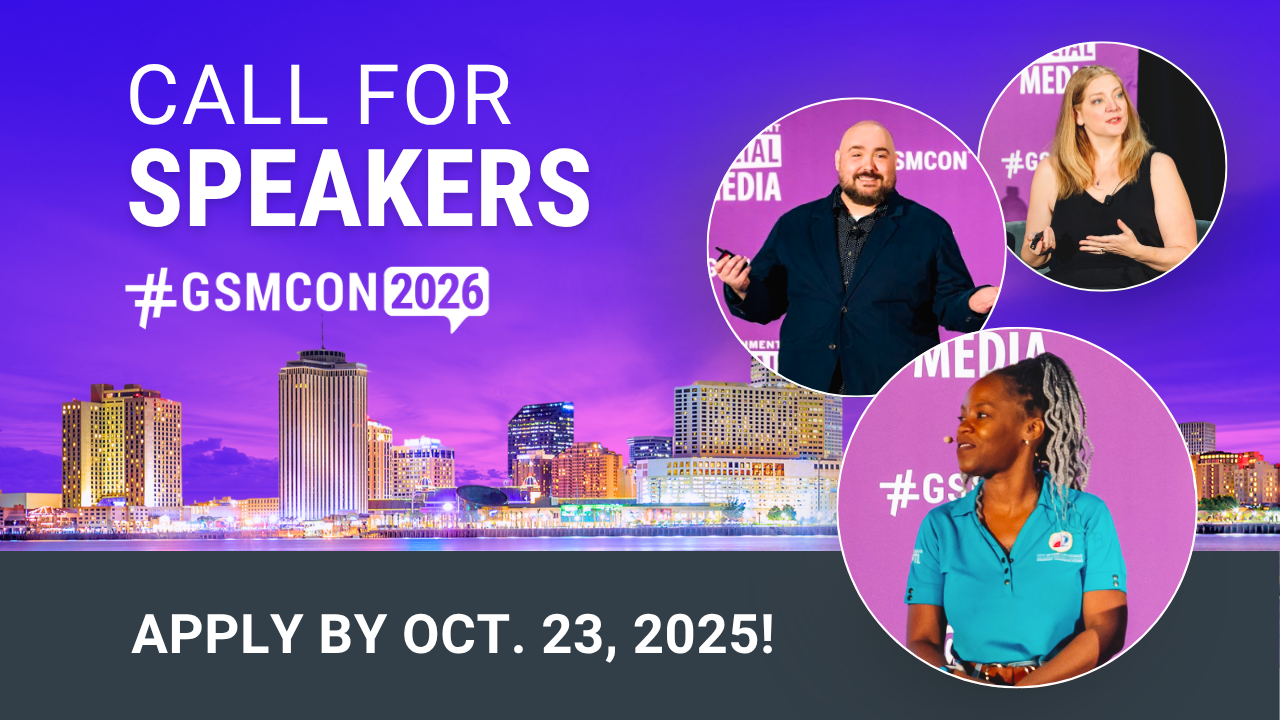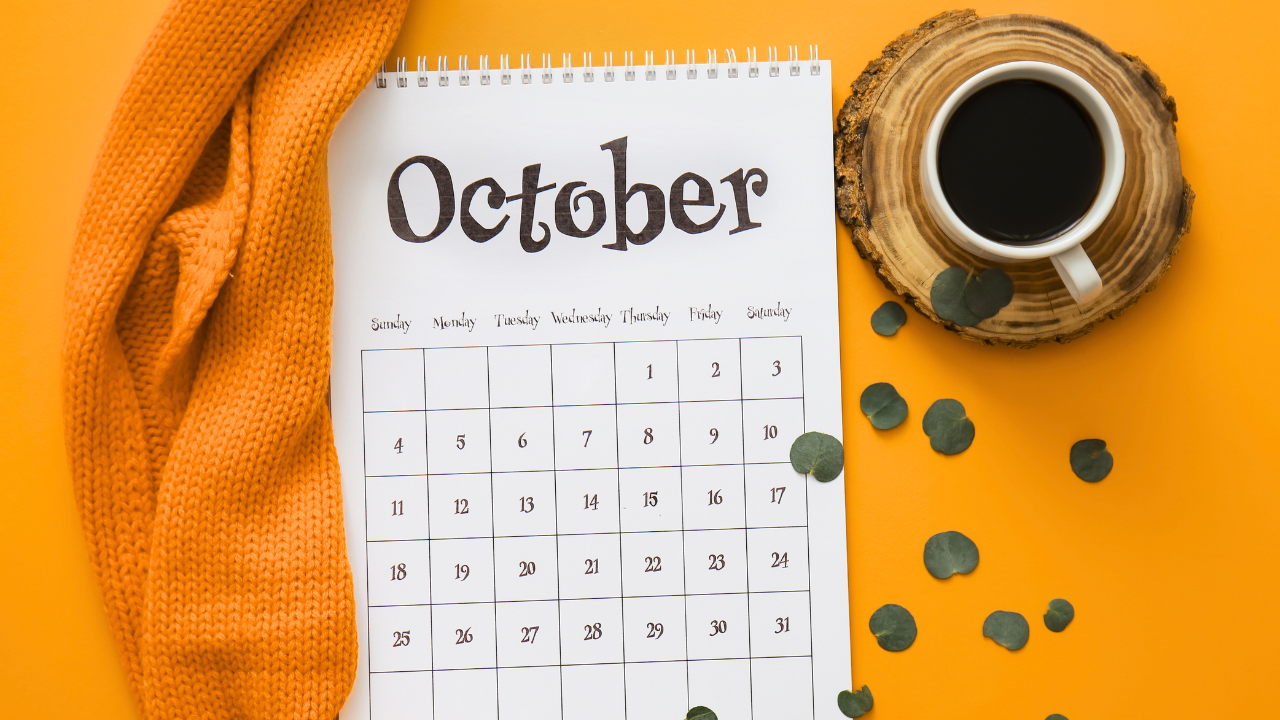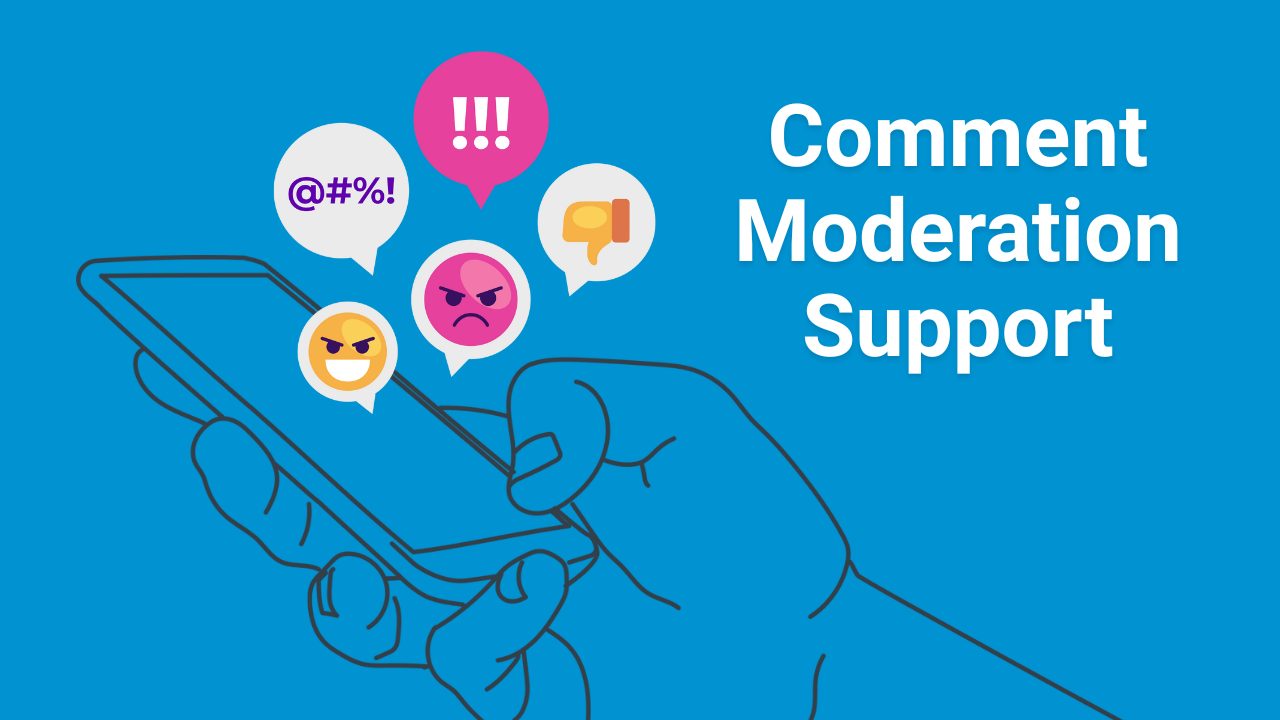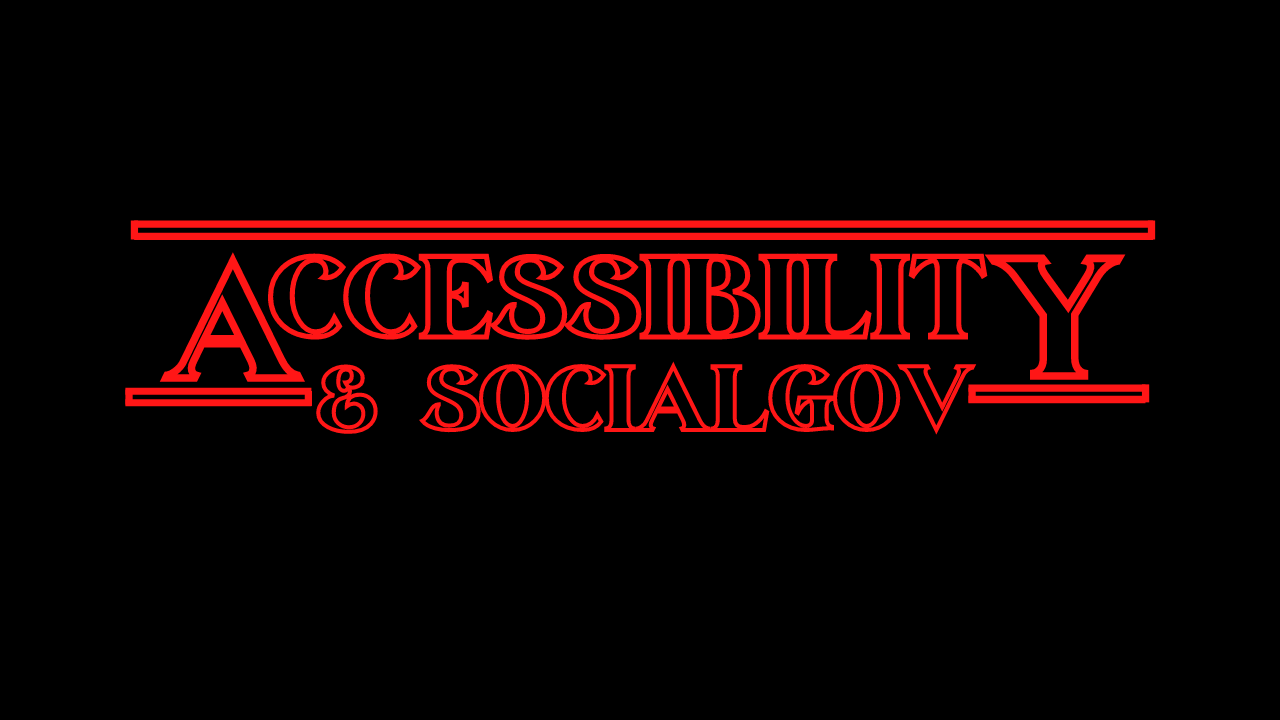
Stranger Things & socialgov? How pop culture trends boost accessibility awareness
Aug 02, 2022Contributed blog by Ariana Donley, Web & Social Media Specialist at Government Social Media
Socialgovs are always encouraged to craft social media content with the goal of harnessing two-way communication. As you weigh all potential outcomes of the messaging you’d like to publish, it’s crucial not to overlook people with disabilities who engage with your content in unique ways. That’s where accessibility comes in.
But, accessibility isn’t just a buzzword or a box to check off your list before you post. While social networks offer built-in ways to quickly make content accessible — such as alternative text (alt text) or auto captions — government social media professionals should always go the extra step to check all auto-generated descriptions to ensure it’s clear and concise.
In certain circumstances, there’s also the opportunity to even go above and beyond, get even more descriptive and connect with the entirety of your audience even more. Let’s take a look at recently trending moments in pop culture that have called more attention to the concept of accessibility and how you can incorporate these expectations into your agency’s social media.
Stranger Things & descriptive captioning
If you haven’t yet watched the latest installment of Stranger Things on Netflix, the only spoilers I’ll share here pertain to accessibility [types with determination while chugging coffee]. The show has been lauded for its plot, character development, acting and meme potential, but more importantly for its dedication to descriptive captioning, which we’ll delve into more below.
Although I’m a person who is able to hear audio, I’ve been watching movies and shows with captions on for more years than I can count. As an avid reader and mother to three sweet (and boisterous!) children, it’s often easier for me to process conversations and other important moments on screen this way. I’ve noticed for quite some time that the captions don’t always read exactly what I hear and that the descriptions for non-verbal moments on screen are often very simple and don’t quite capture the essence of a scene. That is, before I watched this season of Stranger Things.
Each season of Stranger Things gets — dare I say it — stranger. The visuals in season 4 become even more disturbing and sinister than before, and the unsettling sounds are an important part of the story. Rather than settling for simple caption descriptions, the show opted for extremely descriptive captions that really drive the point home and even added to the hearing experience.
Here’s an example:
This is such an awesome article that centers on accessibility and story equity through captioning.
— Jennifer Kretchmer (@dreamwisp) July 8, 2022
I’m so, SO thrilled for the way the #StrangerThings captions are driving new conversations about the value of accessibility.https://t.co/1SDaLuruTg
Rather than simply writing [footsteps] as the season’s main antagonist, Vecna, walks around, the captions say [wet footsteps squelch] to describe the footfalls of the humanoid creature with an exposed muscular structure. By going the extra mile and describing the footsteps in this way, the audience gains more insight into what the character looks and sounds like — creating an immersive experience that helps the audience better identify with the people interacting with this character on screen.
While the embedded tweet above illustrates descriptive captioning for action on screen, the music selections also received highly detailed descriptions. The descriptions were so iconic that they even claimed multiple spots in an article ranking the top 30 best captions from the show, including first place. Here’s just one example: [menacing industrial synth music playing].
This captioning approach set the internet ablaze with praise for the writers. While some poked fun at how specific — and uncomfortable — the captions could be at times, the overall consensus seemed to be that the show helped people recognize the power of descriptive captions.
More Stranger Things captions memes please pic.twitter.com/yF9xKfKQW5
— Author Brad Acevedo 💀 (@wolfsoul4) July 13, 2022
The above embedded tweet pokes fun at the show’s descriptive captioning style of [tentacles squelching wetly] to [macaroni and cheese sounds].
Where does government fit in?
Government agencies can embrace the Stranger Things approach to accessibility to better connect with their social media audiences and provide accessibility that offers more than just generic information — rather, it offers more of the full experience.
Not only could improved accessibility provide better customer service to users with hearing or visual impairments, but it could also help reach younger audiences too, who are known to be more aware of the need for improved accessibility.
As mentioned during a session on Instagram at the 2022 Government Social Media Conference, approximately 40 percent of users on Instagram aren’t using audio. This means captions are in high demand.
Image Alt Text - a real world government example…
In addition to captioning, alt text is another key accessibility practice. The purpose of alt text is to provide a text description of an image for the benefit of users with any visual impairment who use screenreader software; however, it is often overlooked or poorly used.
Another recent trending topic that gained praise for its commitment to accessibility was the alt text on the images from NASA’s James Webb telescope. According to NASA, the telescope is the largest ever launched into space and seeks to help scientists “understand the origins of the universe and our place in it.”
In this example from NASA’s Twitter account, several of the included images have alt text descriptions that offer immense detail and truly capture a snapshot of these sections of the universe.
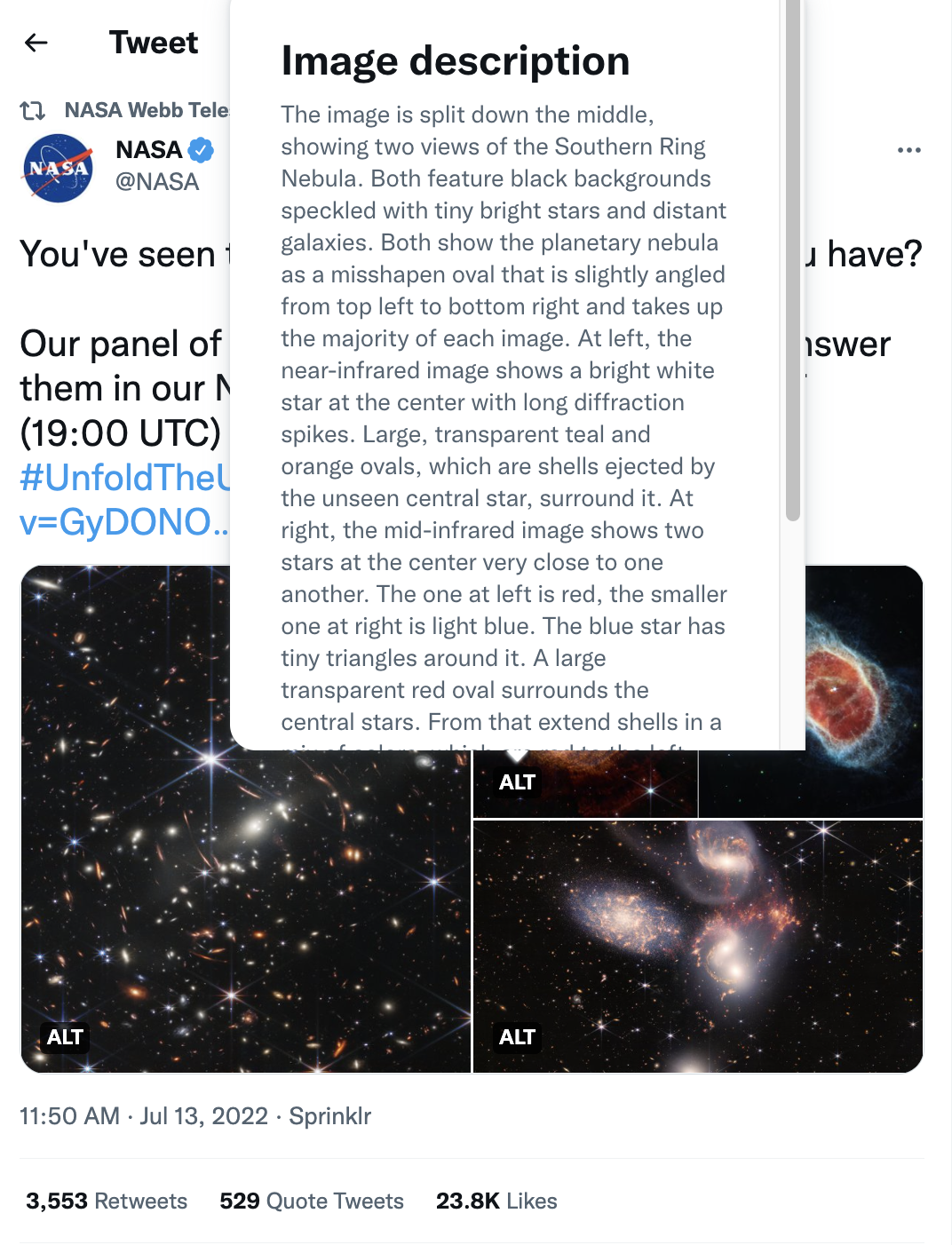
The Alt Text pop-up in the image embedded above reads “Image description. The image is split down the middle, showing two views of the Southern Ring Nebula. Both feature black backgrounds speckled with tiny bright stars and distant galaxies. Both show the planetary nebula as a misshapen oval that is slightly angled from top left to bottom right and takes up the majority of each image. At left, the near-infrared image shows a bright white star at the center with long diffraction spikes. Large, transparent teal and orange ovals, which are shells ejected by the unseen central star, surround it. At right, the mid-infrared image shows two stars at the center very close to one another. The one at left is red, the smaller one at right is light blue. The blue star has tiny triangles around it. A large transparent red oval surrounds the central stars. From that extend shells in a mix of colors, which are red to the left and right and teal to the top and bottom. Overall, the oval shape of the planetary nebula appears slightly smaller than the one seen at left.
It’s inadvisable to depend on auto-generated alt text or captions because they’re often not reliable, very descriptive or could miss the point of the image entirely. Imagine the difference between the above images simply stating “image of outer space” versus what they actually say.
A common saying is that a “picture is worth a thousand words.” While adding a significantly lengthy alt text description on most run-of-the-mill images isn’t typically recommended, more detail on particularly noteworthy images — like the example above — can significantly boost the value of your image descriptions and improve the user experience.
Final thoughts
Accessibility is crucial to ensure all audiences have equal access to the information you put forth on social media, and what we’ve learned from the examples above is that there’s opportunity to go the extra mile to make your social media more descriptive and relatable for your entire audience.
While it does take extra time and care, it’s important to get in the habit of providing accessibility services on all of your content to take the best care of your audience. Getting in the habit can also help you avoid being overwhelmed in a crisis situation since alt text and captioning will already be an integral part of your social media strategy.
As the pop culture moments discussed above prove, it can also be an opportunity to have fun and provide unique information and context to your non-crisis content, when appropriate, to enrich the accessibility experience.
Meet the author
Ariana Donley
Web & Social Media Specialist – Government Social Media LLC
Ariana graduated from Southern Methodist University in Dallas, Texas with a B.A. in Journalism and a minor in Human Rights. She spent several years in the TV news industry and also served the Birmingham Police Department initially as a Crime Prevention Officer and later as the first Public Relations Manager. She is passionate about GSM’s mission and enjoys the positive and supportive team work environment.
Best communicate with the public you serve by becoming a part of the free Government Social Media network — only available to full/part-time employees of government or educational institutions.
We support the largest network of government social media professionals in the U.S. by guiding government agencies through complex social media issues. Government Social Media helps you successfully communicate with the public you serve, protect your agency and keep public trust while finding your support community.
Government Social Media® empowers government professionals to achieve mastery in social media through conferences, online training, and association membership. Best communicate with the public you serve and get connected with fellow socialgovs by registering for the 2026 Government Social Media Conference happening in New Orleans, LA and virtually from wherever you are! Join the free GSM Network for text-only chats on socialgov topics or access the Government Social Media Association (GSMA) for regional virtual meetups and educational webinars.


